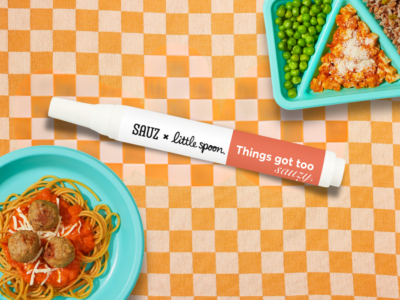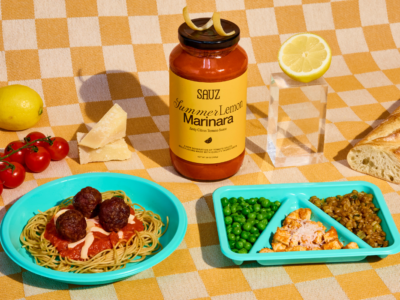While some babies jump into finger foods with gusto, others need a bit more guidance. If your baby is having a hard time moving away from spoonfeeding and on to feeding themselves, using Little Spoon alongside some of these Solid Starts tips will get your baby on the right track.
1. Start by teaching baby to self-feed with a spoon
Learning to self feed is challenging, but learning to chew and manage finger foods adds another layer of challenges. If your baby is happily accepting purees off a spoon, the next step is to encourage self-feeding with purees. That’s where brands like Little Spoon can be a big help! Little Spoon’s Babyblend purees increase in texture as your baby ages, enabling you to introduce new textures to your baby while they build self-feeding skills. Your baby can use their hands or you can use easy-to-hold spoons and spoons that “grip” the food. Keeping a few extra spoons available at the table in case one falls can be helpful. You can also use easy-to-scoop foods for your baby to practice successfully filling the spoon. Little Spoon’s Stage 5 Babyblends are a great place to start and stick with since they help introduce chunkier texture to your kiddo. The Quinoa Raspberry Pudding and Apple Cinnamon Buckwheat Crumble are some of Little Spoon’s favorites.
2. Eat with baby, modeling what to do
Babies learn by watching us and attempting to imitate what they see from their parent. When eating with yourbaby, show them how you pick up food with your hands or bring a spoon to your mouth can help your baby better understand what is expected of them. Little Spoon’s Biteables are made with cut-to-size ingredients to help move on to finger foods. Plus, they have very similar ingredients to what you would be eating along with baby, they’re the perfect place to start!
3. Pair finger foods with purées
One way to do this is to serve the food “two ways,” so you might serve a Babyblend , like Sweet Potato Babyblend, alongside finger foods that feature roasted sweet potato like Little Spoon’s Mini Cheesy Pasta Biteable. Alternatively, you can use chewable foods as the “vehicle” to eat the purées, like a mango spear as the spoon in a purée, an egg strip dipped in hummus, or a spare rib dipped into mashed potatoes. Show your baby how to dip or stir their purées with their finger food to coat it like a spoon.
4. Don’t be discouraged.
If your baby makes a big mess, misses their mouth or spills food all over, it’s okay! This is a normal part of the learning process. Try to keep in mind that the mess has value. As your baby gets messy they are learning through their sensory system about food and how to self-feed. It’s always good to remember that we learn the most from making mistakes. Trial and error learning is where it’s at!
5. Lean on your breast milk or formula feeds
As you work on the transition from spoons and purées to finger foods, you may want to add in a little bit more breastmilk or formula to help support nutrition while your baby learns. They won’t understand how to swallow much (or anything!) in the beginning, and they are used to having purées to help fill their belly. A bit more bottle or breastfeeds can help smooth this transition. You can offer the breast or bottle ~30 mins to an hour before bringing your baby to the table and help them feel calm, organized, and not too hungry to focus. If your baby doesn’t eat much at the table, this is OK–it can be beneficial to give more breastmilk or formula instead of topping off with purée to help them learn that finger food’s job is to fill the belly, not just something to play with before purées come out.



